How to Get Rid OfWoodpeckers
49 min read Updated for November, 2019
Woodpeckers are beautiful, unique and helpful birds that aid in insect control and create tree cavities for other birds and animals who can’t excavate themselves. If you’re a bird watcher, you may long to have a woodpecker nest on your property, but not everyone wants the continual loud noise or the wood damage they can cause.
Most woodpeckers have strong, sharp beaks and long tongues that can extend a good distance. They have stiff feathers and short legs with toes that have sharp claws and two of the four point backward. These features allow woodpeckers to brace themselves and hold on easily to whatever they’re pecking—including your trees, wood posts and other parts of your home and property.
49 min read Updated for November, 2019

Woodpecker Sounds
Outside of the obvious tap-tap-tap wood drilling, the call or sounds each species of woodpecker makes couldn’t be more different. Woodpecker sound variations include a loud ‘peek’ call, a song in a descending rattle, a wick-wicka-wicka or kuk-kuk-kuk or chuck-chuck-chuck chant, a churring, or a nasal ‘weeah’ or ‘meeww’.
Woodpecker Tracks
Most evidence of woodpeckers will be their handiwork and/or destruction of trees. Unlike most birds, woodpeckers have two sharply clawed toes pointing forward and two pointing backward, helping grasp their tree perch and balance while they drill. This toe arrangement allows them to climb up and down tree bark (while most birds can just climb up).
Woodpecker Poop
Woodpecker poop can vary in color and consistency depending on their diet but it’s generally a liquid consistency, whitish (waste from the kidney that seems to wrap abound the feces), and splatters. You will notice an increase of this splatter on the trees woodpeckers favor or nest.
Identify
Common Species
There are more than 300 different types of woodpeckers throughout the world, but only about two dozen species call the United States home. Unlike most birds, woodpeckers use their bills to drum into the wood. They have a shock-absorbing system in their heads that keeps their brains from hitting their skull, and their skulls are heavier than most birds, so they can withstand the continual impact.
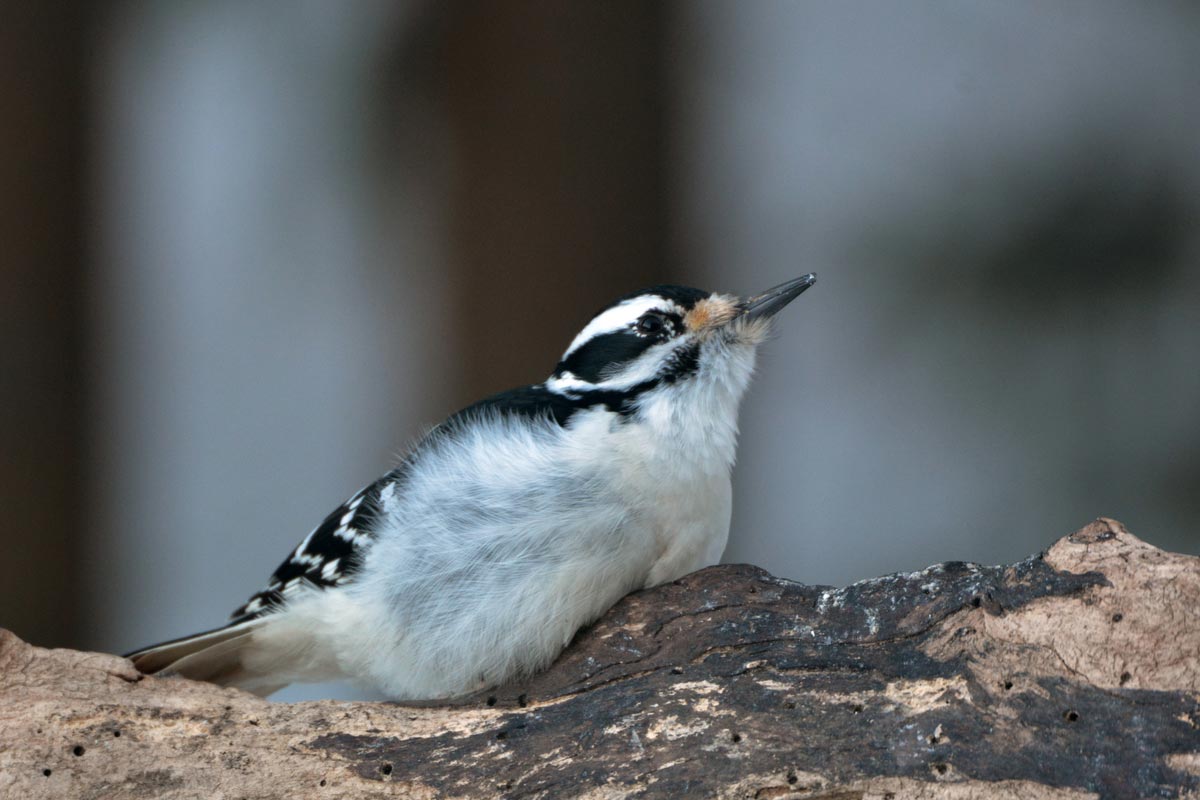
Downy Woodpecker
Downy Woodpeckers are the most common and smallest woodpecker in the United States, but their lifespan may be one of the shortest. They typically only live between one and two years and have a hard time surviving winter.
Appearance
- Between six and seven inches tall, weighs an ounce or less, a wingspan between 10 and 12 inches
- Short black bills, white breasts, black and white backs, males have a red nape
- Spotted tail feathers
Behavior
- Eats insects, grubs, fruit, and seeds
- One of few woodpeckers that will feed at the feeder
- Sing in a descending rattle
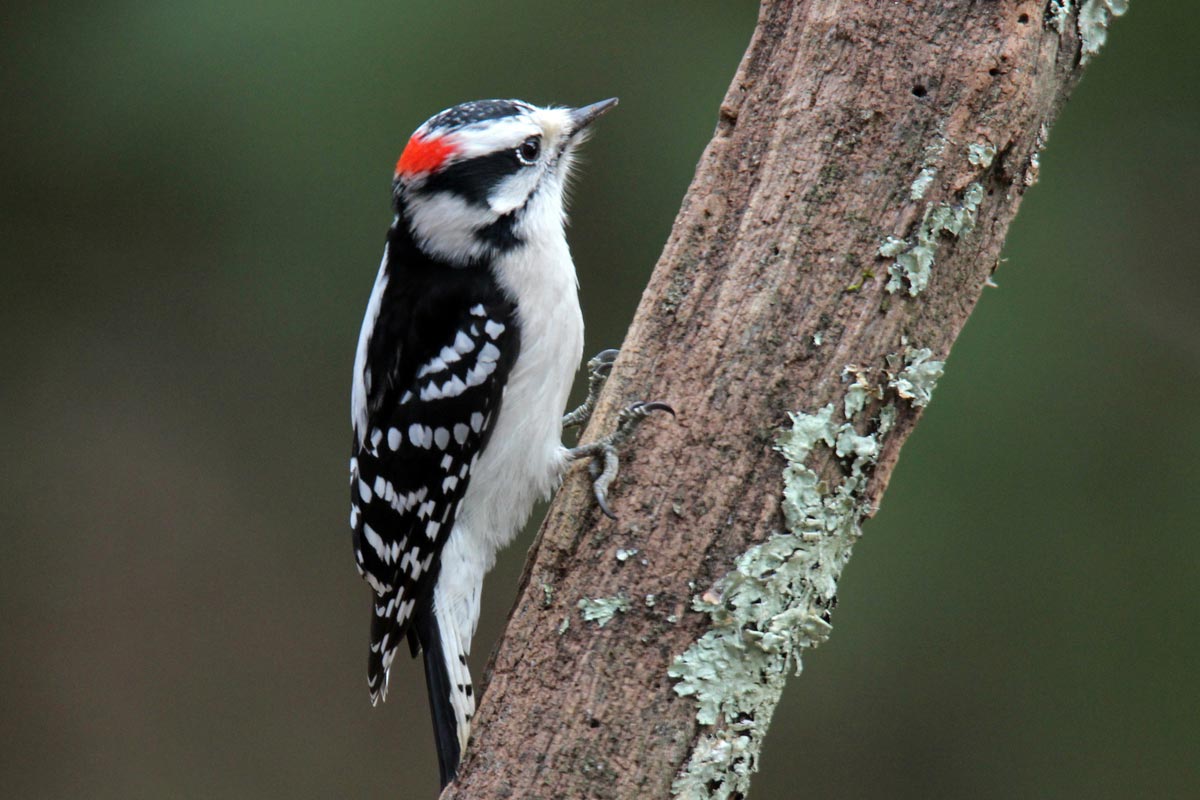
Hairy Woodpecker
The Hairy Woodpecker is, for the most part, a larger version of the Downy Woodpecker, but there aren’t as many of them. Studies show this type of woodpecker is particularly attracted to areas of forests that have recently burned.
Appearance
- Between nine and 13 inches tall, weighs up to four ounces, nearly 15-inch wingspan
- White breast with black and white backs and long, white outer tail feathers
- Long, chiseled bill almost as long as head, males have a red nape
Behavior
- Mostly confined to towering trees and larger, older woodlands
- Eats insects, spiders, fruit, seeds, and suet from the backyard
- Loud, explosive peek call
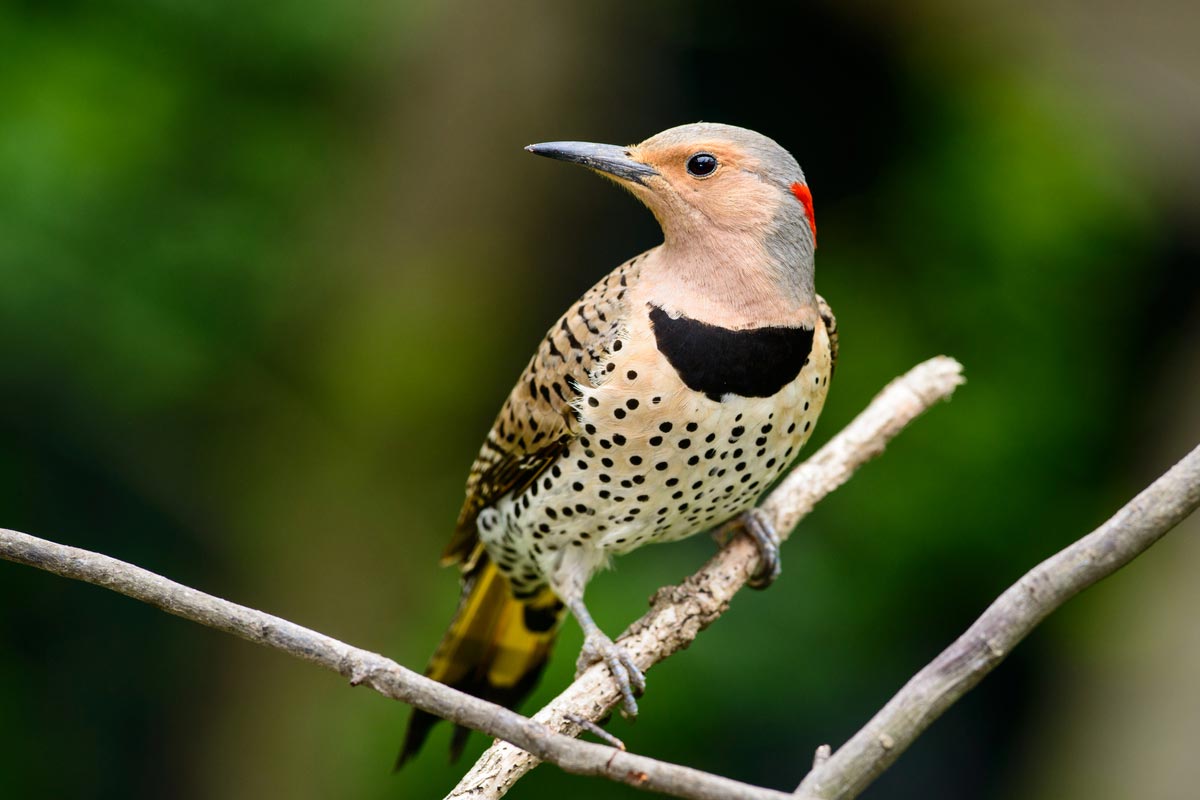
Northern Flicker
Northern Flickers stay grounded more than most other woodpeckers. That’s because they eat a lot of ground-dwelling insects and they will often hammer into the ground like other woodpeckers drill into wood. There are two types of Northern Flickers: a Red-shafted Flicker and a Yellow-shafted Flicker.
Appearance
- Brown with black spots and white rump patch that shows in flight
- Eastern birds have bright yellow tail feathers, western birds have red tail feathers
- Between 11 and 12 inches tall, weighs between four and five and a half ounces, a wingspan between 16 and 20 inches
Behavior
- Found in open country near large trees, city parks, small woodlots
- Eat insects, especially ants, berries and seeds
- During courtship males make wicka, wicka, wicka sound
Woodpecker Problem?
If you hear a call that sounds like kuk-kuk-kuk, you’re listening to a Pileated Woodpecker.
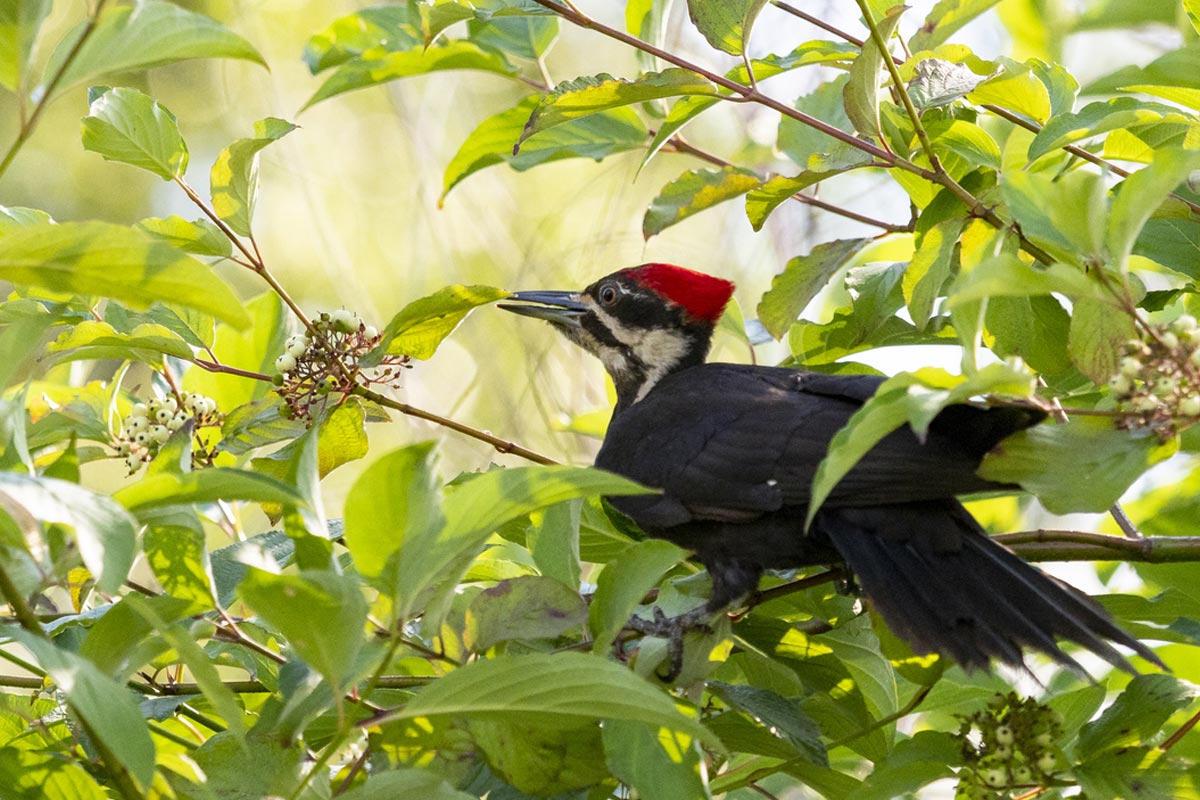
Pileated Woodpecker
These loud birds with whiny calls are the largest woodpecker found in the United States. If you hear a call that sounds like kuk-kuk-kuk, you’re listening to a Pileated Woodpecker. They are comparable to a crow in size.
Appearance
- Long neck, chiseled bill, triangular red crest
- Dark feathers with white stripes on face, males have a red stripe on the cheek
- Between 15 and 20 inches long, weighs between eight and 12 ounces, a wingspan between 26 and 29 inches
Behavior
- Drill rectangular-shaped holes in rotten wood, live in dead trees
- Feed off carpenter ants, beetle larvae, termites, and other insects
- Mate for life, hold large territories
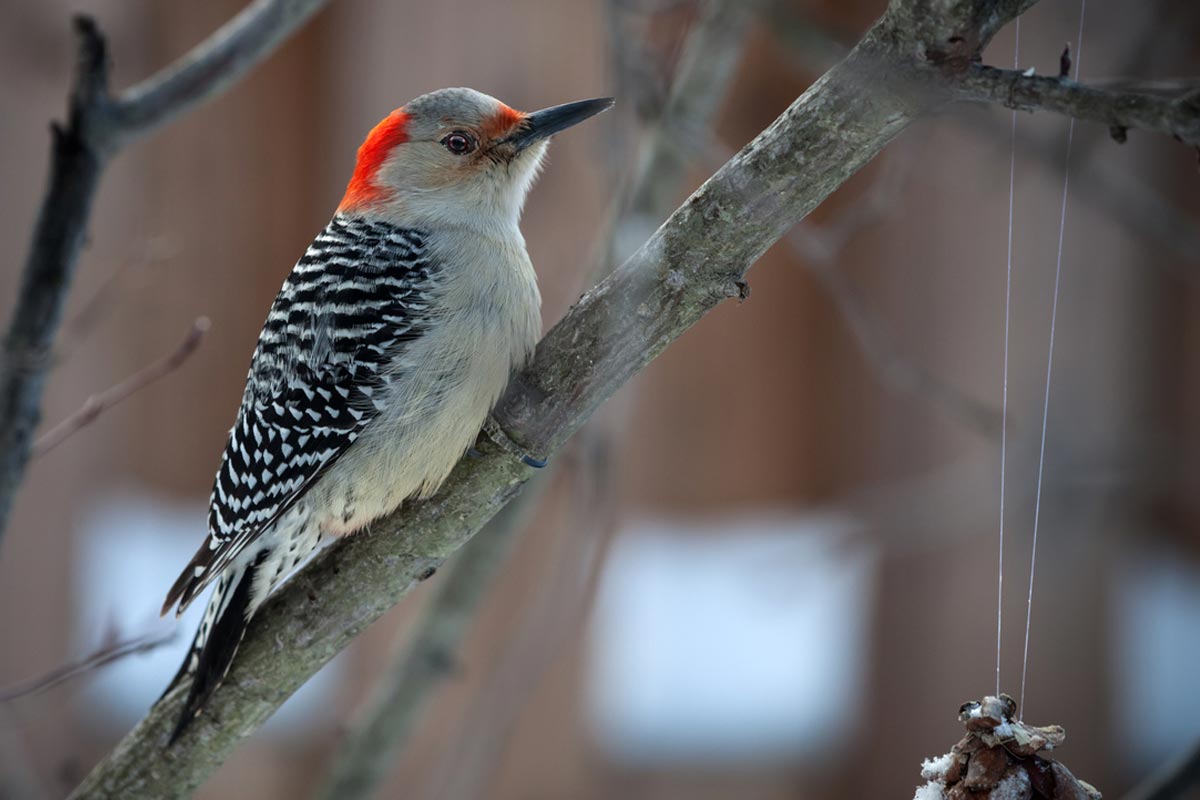
Red-Bellied Woodpecker
Despite the name, you often don’t see much red on the belly of the Red-bellied Woodpecker; it can often be covered up with their white feathers. Red-bellied Woodpeckers don’t migrate, but they have expanded their territories northward.
Appearance
- Pale gray breast, black and white zebra-striped back and wings, faint reddish tint on the belly
- Males have red crown and neck, females only have a red neck
- Between nine and 11 inches tall, weighs less than three ounces, wingspan is nine to 10 inches
Behavior
- Lives in forests, woodlands, groves, orchards, towns, and parks
- Eats insects, larvae, nuts, berries
- Call is a chuck, chuck, chuck or a churr
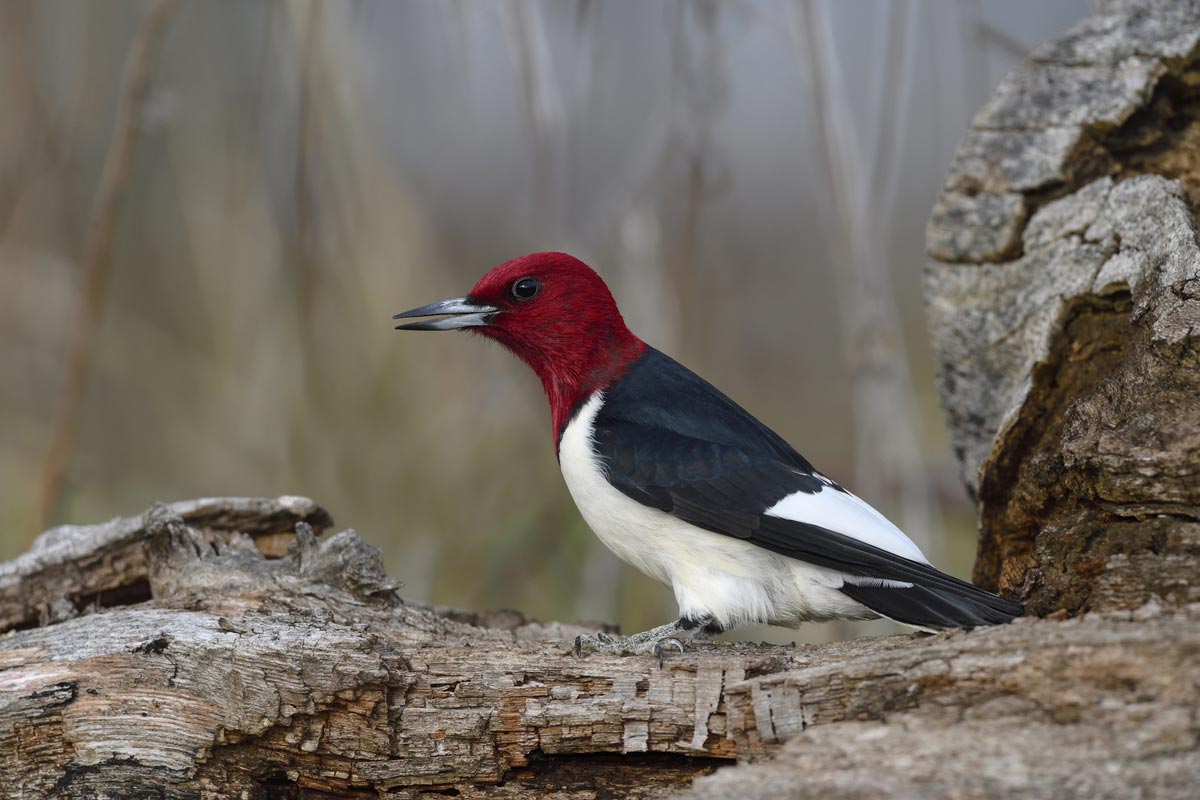
Red-Headed Woodpecker
Unlike a lot of other woodpeckers, the male and female Red-headed Woodpecker look exactly the same. Wildlife experts say these woodpeckers will fly out from their perch to catch insects in the air or on the ground.
Appearance
- White breast, black tail
- Black and white wings, scarlet red head
- Noticeable large, white squares on wings when in flight
Behavior
- Lives in open wooded areas with oak, hickory trees, or in utility poles
- Eats nuts, acorns, insects
- Loud calls, sound like churr-churr or yarrow-yarrow-yarrow
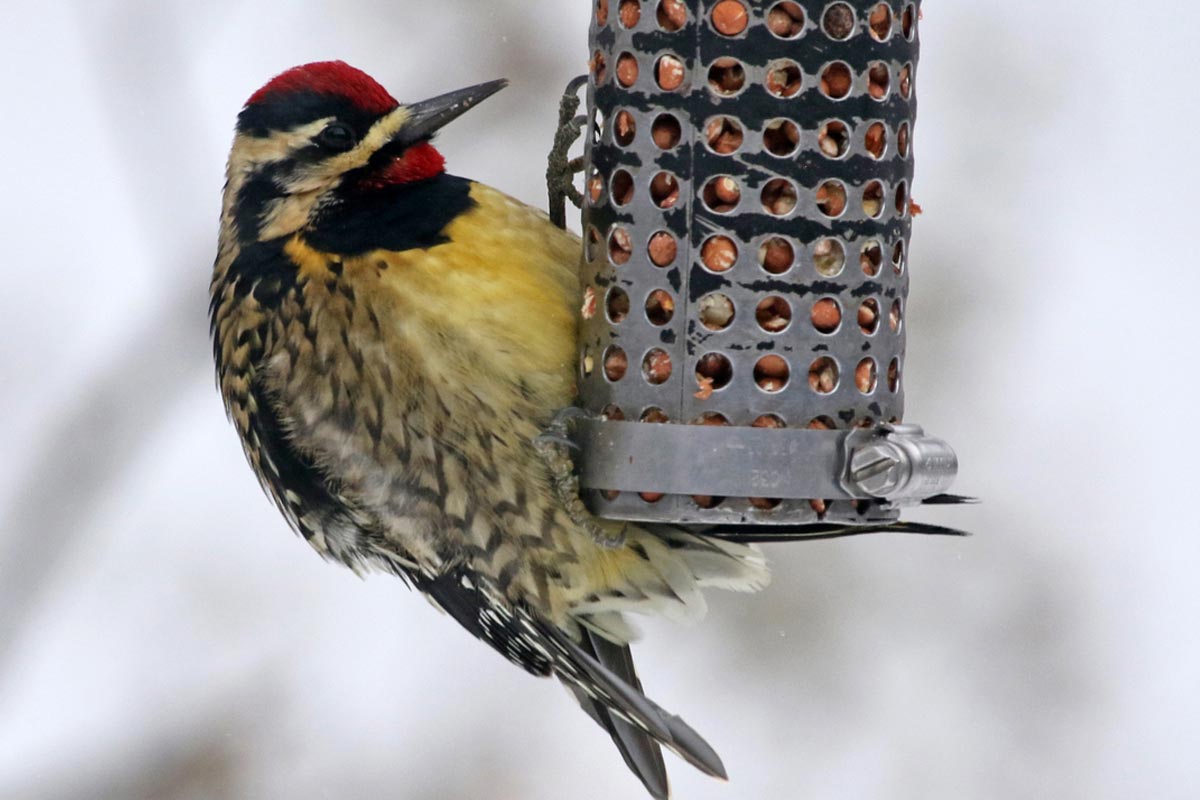
Yellow Bellied Sapsuckers
The Yellow-bellied Sapsucker is medium in size and can be found mostly in the northern and eastern part of the United States. It’s the most highly migratory woodpecker in the U.S. It leaves for warmer climates in September and October. The Yellow-bellied Sapsucker has a nasal weeah or meeww sound. When it becomes territorial, you’ll hear a loud quee-ark.
Appearance
- Black and white bodies with yellowish bellies
- Red crowns, males have red throats
- Eight to nine inches long, weighs about two ounces, wingspan is 16 inches
Behavior
- Eats insects, sap, fruit
- Drill small, evenly spaced rows of holes in trees for sap, maintain them daily
- Alternate between rapid drilling thumps and slow rhythmic ones
Like most woodpeckers, the Pileated Woodpecker drums into the wood to attract mates and establish territorial boundaries.
Common Locations
Downy Woodpeckers can be found year-round in many parts of the United States, except for Hawaii, and parts of Alaska, Arizona, California, New Mexico, Nevada, and Texas. They prefer open forests with deciduous trees, but you can often find them in parks and backyards. These woodpeckers seem to be the most adaptable and least affected by developments that take away forests and woods.
They are typically permanent residents, but Downy Woodpeckers that live in the northern part of the U.S. will migrate a short way for warmer temperatures.
Hairy Woodpeckers can live anywhere across the United States, at sea level or in the mountains across the country. The southern part of California is about the only place in the U.S. you won’t find them. They prefer big trees, and you will usually find them spending time in tree trunks.
Hairy Woodpeckers can also occupy the suburbs, parks, and cemeteries. If they’re in the woods, the best place to look to see them is along the forest edge, near beaver ponds, southern swamps, orchards or in pine, oak or birch woodlands.
Northern Flickers live in wooded areas all across the United States. There are two types of Northern Flickers: the Red-shafted Flicker lives in the western part of the U.S., and the Yellow-shafted Flicker lives in the eastern region. Their hybrid zone runs through the Great Plains.
They will live in any type of forest, including areas that have been burned out. You’ll find them as high as the tree line. Flooded swamps, marsh edge, city parks, and suburbs are also places Northern Flickers call home.
Pileated Woodpeckers commonly live in forests where there are plenty of fallen, dead or deteriorating trees, but they can also reside in city parks. They can be spotted all along the east coast of the United States, as far west as Texas and as far north as Minnesota. A few have been seen in the Pacific Northwest.
You may hear them long before you see them. Like most woodpeckers, the Pileated Woodpecker drums into the wood to attract mates and establish territorial boundaries. The hammering sound can carry a long distance through the woods.
Red-bellied Woodpeckers live mainly in the southeastern United States near swamps and rivers in wooded areas, although they have begun to expand their range northward. They are most abundant in the forests of Georgia and North and South Carolina.
These woodpeckers are adaptable and can often be seen in suburbs and city parks. The more northern their habitat, the more likely they are to migrate during the winter. They are highly adaptable birds, so it isn’t unusual to spot a Red-bellied Woodpecker in the edge of a forest or clearing in the woods, a grove of trees on a farm or a shade tree in a developed part of town.
Red-headed Woodpeckers were once very common throughout the eastern United States, but, for some unknown reason, have been decreasing in numbers in the past several years. Red-headed Woodpeckers are found mostly now in the Southeast and tend to migrate only short distances. They live in groves, farms, orchards and shade trees in towns. They prefer open country and clearings in the woods to dense forests.
Yellow-bellied Sapsuckers were once plentiful in the South but now are seen mostly in the North and East part of the United States. They tend to prefer young trees, especially aspen and birch, found near streams. During the winter, they aren’t as particular and can be located in semi-open wooded areas. If you have young birch or maple trees in your yard, you may hear a Yellow-bellied Sapsucker’s drilling.
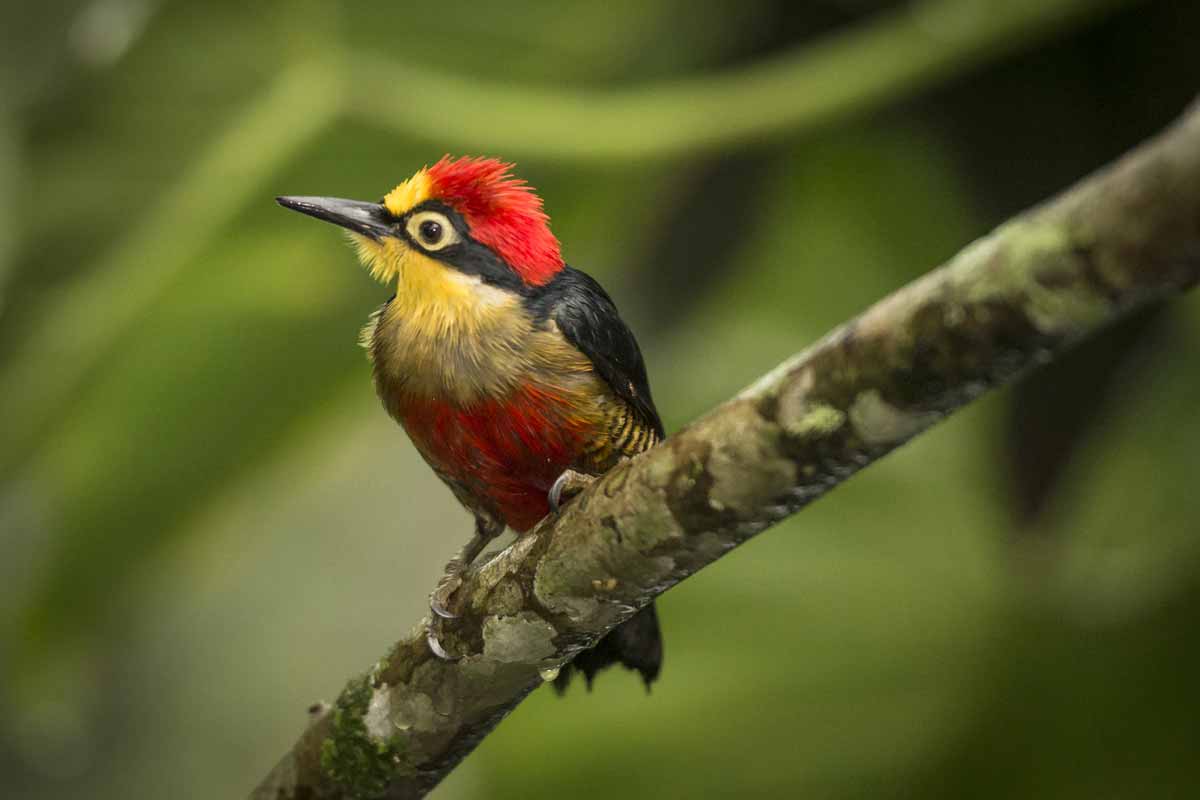
Woodpeckers tap between 8,000 and 12,000 times a day..
Why They’re Here
Any kind of woodpecker you encounter is probably looking for shelter, food or a mate. Their constant and loud pecking can become quite annoying. Woodpeckers tap between 8,000 and 12,000 times a day.
Pileated Woodpeckers use their beaks to dig under tree bark for food. This type of woodpecker prefers big, old, decaying trees for nest building and they don’t care if the tree is deciduous or coniferous. Once they’ve established a nest, the Pileated Woodpecker will live there all year long. They, like most woodpeckers, mate for life and both care for their eggs.
By and large, Pileated Woodpeckers are helpful. They keep a forest healthy by eating wood-boring insects that infest trees. But sometimes, they can create a hole so big they weaken and damage small, young trees and cause them to break in half.
Hairy and Downy Woodpeckers are very similar. The Harry Woodpecker is just a little bigger than the Downy, but they are often found living together. They aren’t too picky. As long as there is a tree around, these two woodpeckers can find a home. Although, Hairy Woodpeckers are often forced to find new nesting sites because Starlings and House Sparrows will take over their freshly excavated tree cavities.
There are nearly seven million Northern Flickers in North America. They are considered city birds since they are more common in cities and parks than out in the wilderness. They nest in tree cavities and prefer aspens. They will often be seen drilling in the ground for ants and other larvae.
Northern Flickers are also known as Yellow Hammers and are the state bird of Alabama, which is a unique designation. They are the only the woodpecker that has been named as a state bird.
Red-bellied Woodpeckers are fairly common. There are about ten million living around the world. Males forage on tree trunks, while females forage higher in the tree and on the limbs. Red-bellied Woodpeckers store food for later. They will put away nuts, acorns, corn, fruits, and seeds in cracks and crevices in trees or wood posts.
Red-headed Woodpeckers like old, tall trees but they spend winter where the food is. You will find them during cold months based on where they’ve found plenty of acorns and food. They sometimes feed on fruits and vegetables, which can cause trouble for farmers. But they’re a favorite among birdwatchers.
Yellow-bellied Sapsuckers excavate a new hole every year, but they may use the same tree over and over. It takes about three weeks for them to finish carving out their nest. They are the only woodpecker in eastern North America that is entirely migratory. Females will usually migrate farther south than the males do.
It’s not unusual for Yellow-bellied Sapsuckers to be seen or heard drumming on human-made materials. Things like street signs and metal chimneys amplify their drilling noise, and they have been known to return daily to a favorite piece of metal to hammer.
Woodpecker Sounds
Outside of the obvious tap-tap-tap wood drilling, the call or sounds each species of woodpecker makes couldn’t be more different. Woodpecker sound variations include a loud ‘peek’ call, a song in a descending rattle, a wick-wicka-wicka or kuk-kuk-kuk or chuck-chuck-chuck chant, a churring, or a nasal ‘weeah’ or ‘meeww’.
Woodpecker Tracks
Most evidence of woodpeckers will be their handiwork and/or destruction of trees. Unlike most birds, woodpeckers have two sharply clawed toes pointing forward and two pointing backward, helping grasp their tree perch and balance while they drill. This toe arrangement allows them to climb up and down tree bark (while most birds can just climb up).
Woodpecker Poop
Woodpecker poop can vary in color and consistency depending on their diet but it’s generally a liquid consistency, whitish (waste from the kidney that seems to wrap abound the feces), and splatters. You will notice an increase of this splatter on the trees woodpeckers favor or nest.
Inspect
Why Are Woodpeckers Drilling In My House?
There are only a few reasons a woodpecker may be hammering or drilling on your house.
They like the sound.
It can be just that simple. The noise the woodpeckers’ bill makes against the material in your home may be satisfying, help them claim their territory and attract a mate. They like to hammer on aluminum siding, trim boards, metal downspouts, gutters, chimneys, and vents. If this is the reason, a woodpecker will stop in the spring when breeding begins.
They need a nest.
Nesting holes are round and large and usually built in April and May. Woodpeckers will build nests in homes close to wooded areas. They prefer redwood and cedar and like natural or dark stained wood, shakes, grooved plywood, board-and-batten, and tongue-and-groove siding.
They are eating.
Woodpeckers may be using your home as a buffet. If they are searching for insects to eat, they will drill several rows and lots of holes to feed.
Gather The Tools You’ll Need
Burlap or netting
for covering areas of wood on your home
Hammer and nails
for hanging reflective streamers
Gloves
to protect your hands from splinters and other dangers
Masks
to avoid breathing in any spores or fungus left behind by woodpeckers
Ladder
for climbing up to reach wood areas you can’t reach from the ground
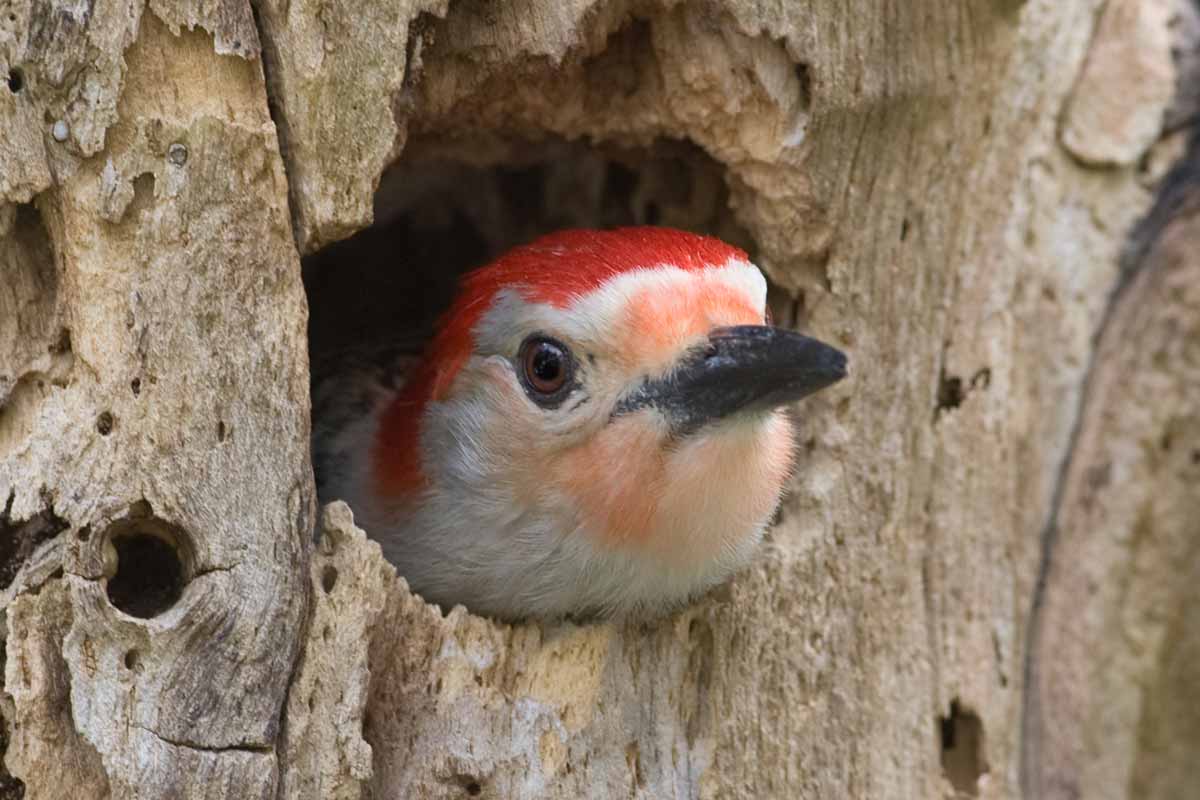
Woodpecker Problem?
Many woodpeckers will feed on suet, so if you add this type of feeder, the woodpecker may be drawn to it, instead of your wood posts.
How To Steps For DIY Removal
Getting rid of woodpeckers is not something you want to take a wait and see approach to. You should start trying to get rid of them from the moment you hear the first pecking to keep the damage minimal. The Cornell Lab of Ornithology tested tested six common deterrents to see which ones worked the best for woodpeckers.
Researchers tested life-size plastic owls, reflective streamers, plastic eyes on fishing line, roost boxes, suet feeders and a sound system playing woodpecker distress calls. The Cornell Lab found the most effective deterrent was the reflective streamer. For the most part, its shiny movement kept the woodpeckers away. The other deterrents didn’t have long-term success.
Some homeowners have also found success in hanging windsocks, pinwheels, or wind chimes. The continual movement and noise can be a deterrent.
You may want to consider adding or moving a suet feeder. Suet is the hard fat found around the kidneys and loins in beef and mutton and is located at pet stores or co-ops. It’s a high energy food that’s easily digested by birds, and it’s highly valuable to them when the weather is cold.
Many woodpeckers will feed on suet, so if you add this type of feeder, the woodpecker may be drawn to it, instead of your wood posts. If you have one already, you may want to move it away from your house, to create a broader, less convenient range between the feeder and your home. If you add this type of feeder to draw woodpeckers away from your home, make sure the feeder is one where the birds feed hanging upside down. Otherwise, you’ll attract starlings.
Don’t use any kind of repellent that’s sticky. The bird’s feet or feathers can get stuck and keep them from being able to get away, resulting in injury or death. Woodpeckers are classified as migratory nongame birds and are protected by the Federal Migratory Bird Treaty Act, making it illegal to kill or harm them.
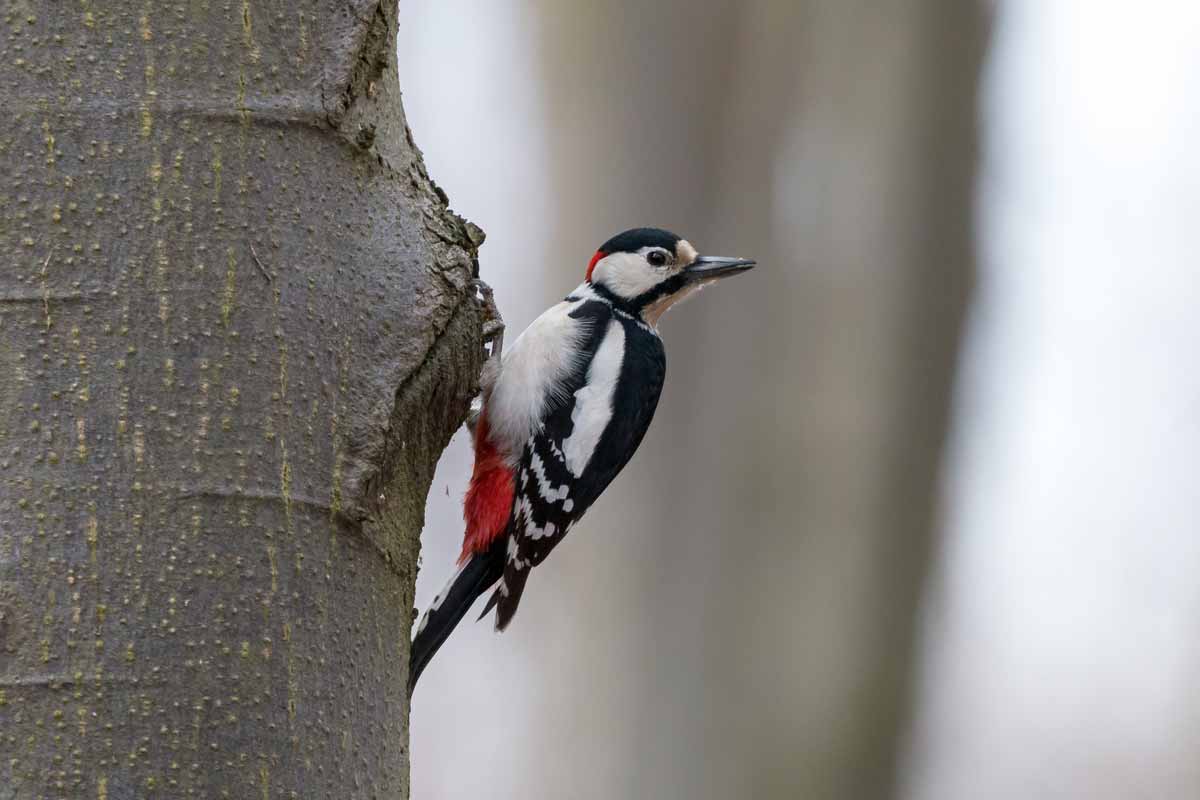
Woodpeckers whack their heads against trees with a force ten times harder than a football tackle that causes a concussion.
Risks Of Disease
By and large, woodpeckers do not present a significant health hazard to humans. The only real concern is any cross-contamination from the feces they may leave behind.
Histoplasmosis is a respiratory disease. You can become infected by breathing in spores of the fungus that grows on bird droppings. It isn’t contagious, but it is most commonly transmitted when the spores become airborne during cleanup. Most people who have it never develop symptoms and don’t realize they’re infected. If you do develop symptoms, they will show up in three to 17 days of exposure and include: include:
- Fever
- Chills
- Headache
- Muscle aches
- Dry cough
- Chest discomfort
Before cleaning up bird droppings, spray the area thoroughly with water. The water can help keep the spores from being released in the air.
Woodpeckers may end up being beneficial in disease treatment in humans. Woodpeckers whack their heads against trees with a force ten times harder than a football tackle that causes a concussion. Their repeated drilling produces a protein in their brains call tau. An abnormal buildup of tau in humans is considered a sign of brain damage and is thought to contribute to chronic traumatic encephalopathy (CTE) and other neurodegenerative diseases like Alzheimer’s. But excessive amounts of tau in woodpeckers doesn’t negatively affect their brains.
Researchers are hoping by studying tau buildup in woodpeckers, and it can offer some answers on understanding neurodegenerative diseases in humans and possibly better treatment.
Woodpecker Sounds
Outside of the obvious tap-tap-tap wood drilling, the call or sounds each species of woodpecker makes couldn’t be more different. Woodpecker sound variations include a loud ‘peek’ call, a song in a descending rattle, a wick-wicka-wicka or kuk-kuk-kuk or chuck-chuck-chuck chant, a churring, or a nasal ‘weeah’ or ‘meeww’.
Woodpecker Tracks
Most evidence of woodpeckers will be their handiwork and/or destruction of trees. Unlike most birds, woodpeckers have two sharply clawed toes pointing forward and two pointing backward, helping grasp their tree perch and balance while they drill. This toe arrangement allows them to climb up and down tree bark (while most birds can just climb up).
Woodpecker Poop
Woodpecker poop can vary in color and consistency depending on their diet but it’s generally a liquid consistency, whitish (waste from the kidney that seems to wrap abound the feces), and splatters. You will notice an increase of this splatter on the trees woodpeckers favor or nest.
Prevent
Prevention Methods
Woodpeckers are an essential part of our environment because they help control the insect population, but they can also cause property damage. And as much as you may want to get rid of the insects around your yard, you may not want to risk your wood siding to do it.
The first and main thing you will want to do to ensure woodpeckers aren’t loudly drilling their way through your property is to have your home and yard inspected by a pest control company. Woodpeckers feed off wood-boring insects, so, you’ll need to check and see if you have a termite or other type of insect infestation. If so, you’ll need to treat that quickly to keep the woodpeckers away.

Burlap or thick netting used for garden or fruit trees can also be effective. You use it to cover the wood siding or any other area of concern at your house. The netting keeps the birds from being able to land and perch on the side of your house. Make sure it’s taut and at least three inches from the siding, so the birds won’t peck through it. You will have to leave the netting up for a few weeks or even months, but eventually, the woodpeckers will leave and find a new area.
If woodpeckers have used your home for a pecking ground in the past, you’ll want to repair the damage they’ve left behind. Once a woodpecker drills into your home, others will be drawn to it. An open hole allows a place for insects to crawl in and infest the area. So, use wood putty to fill up the holes as soon as you find them. Once the putty dries, paint over it with polyurethane or oil-based paint.
Woodpecker Problem?
Woodpecker Sounds
Outside of the obvious tap-tap-tap wood drilling, the call or sounds each species of woodpecker makes couldn’t be more different. Woodpecker sound variations include a loud ‘peek’ call, a song in a descending rattle, a wick-wicka-wicka or kuk-kuk-kuk or chuck-chuck-chuck chant, a churring, or a nasal ‘weeah’ or ‘meeww’.
Woodpecker Tracks
Most evidence of woodpeckers will be their handiwork and/or destruction of trees. Unlike most birds, woodpeckers have two sharply clawed toes pointing forward and two pointing backward, helping grasp their tree perch and balance while they drill. This toe arrangement allows them to climb up and down tree bark (while most birds can just climb up).
Woodpecker Poop
Woodpecker poop can vary in color and consistency depending on their diet but it’s generally a liquid consistency, whitish (waste from the kidney that seems to wrap abound the feces), and splatters. You will notice an increase of this splatter on the trees woodpeckers favor or nest.
When to Call a Professional
For the most part, getting rid of woodpeckers is a do-it-yourself kind of job. But there are a few things you can do that may require a professional.
Most woodpeckers prefer dead trees, and bugs and insects like them too. So, you may want to call an arborist or someone who cuts down trees to identify any dead trees on your property and have them removed.
If woodpeckers are feeding in the wood of your home, you may have an insect infestation. You will need to contact a wildlife or pest control expert to identify the problem and treat it.
Depending on the damage they cause, you may need a carpenter or a contractor to make professional repairs to the holes woodpeckers create.
If you notice a woodpecker on your property that’s injured or in need of help, a wildlife expert will need to be called to remove the bird and take it to a place it can be cared for appropriately.
Sources
https://web.extension.illinois.edu/cfiv/homeowners/000415.html
https://extension.psu.edu/woodpeckers
https://kids.nationalgeographic.com/animals/pileated-woodpecker/#pileated-woodpecker-hammering-tree.jpg
https://www.audubon.org/news/how-tell-hairy-woodpecker-downy-woodpecker
https://www.nationalgeographic.com/animals/birds/p/pileated-woodpecker/
http://www.tnwatchablewildlife.org/details.cfm?displayhabitat=forest&sort=aounumber&typename=FOREST&uid=09041917125021407&commonname=Yellow-bellied%20Sapsucker
https://www.nps.gov/shen/learn/nature/downy-woodpecker.html
http://wildlife.ohiodnr.gov/species-and-habitats/species-guide-index/birds
https://www.audubon.org/field-guide/bird/red-bellied-woodpecker
https://news.aces.edu/blog/2017/06/02/alabama-state-bird-northern-flicker/
https://extension.psu.edu/woodpeckers-making-holes-in-cedar-siding
http://www.birds.cornell.edu/wp_about/holes.html
https://birdsna.org/Species-Account/bna/species/norfli/introduction
http://www.sciencemag.org/news/2018/02/could-woodpeckers-teach-nfl-how-prevent-brain-injuries
https://www.pests.org/get-rid-of-woodpeckers/
http://www.biokids.umich.edu/critters/Melanerpes_carolinus/
www.allaboutbirds.org
Woodpecker Problem?
Sources
https://defenders.org/woodpeckers/basic-facts
http://projectbeak.org/adaptations/feet_climbing.html
Woodpecker Sounds
Outside of the obvious tap-tap-tap wood drilling, the call or sounds each species of woodpecker makes couldn’t be more different. Woodpecker sound variations include a loud ‘peek’ call, a song in a descending rattle, a wick-wicka-wicka or kuk-kuk-kuk or chuck-chuck-chuck chant, a churring, or a nasal ‘weeah’ or ‘meeww’.
Woodpecker Tracks
Most evidence of woodpeckers will be their handiwork and/or destruction of trees. Unlike most birds, woodpeckers have two sharply clawed toes pointing forward and two pointing backward, helping grasp their tree perch and balance while they drill. This toe arrangement allows them to climb up and down tree bark (while most birds can just climb up).
Woodpecker Poop
Woodpecker poop can vary in color and consistency depending on their diet but it’s generally a liquid consistency, whitish (waste from the kidney that seems to wrap abound the feces), and splatters. You will notice an increase of this splatter on the trees woodpeckers favor or nest.




